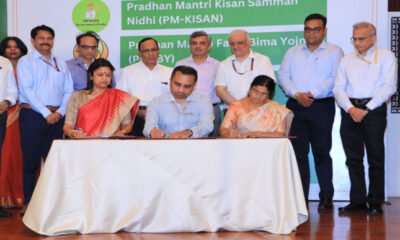Business
Circular economy is the key to sustainable development in India
Rashika.
“If you’re not buying recycled products, you’re not really recycling”. – Ed Begley, Jr.
Circular economy is an economy system in which resources are used for as long as possible by extracting or gaining maximum utilisation whilst in use and then reduce,regenerate and recycle products and materials at their end of service life.
Circular economy encourages use of biological nutrients in products manufacturing so that environmental damage is minimised at the end of their service life and they can be disposed of in nature in a respectful manner and other products with technical nutrients or those which are not eco-friendly(batteries,electronics etc.) should be renewed to make a new useful product.
A report by the Ellen MacArthur Foundation shows that circular economy can bring annual benefits of ₹40 lakh crore in India by 2050 and according to the analysis there will be around 44% reduction in greenhouse gas emissions by 2050.
This is how Bank Mergers will impact the Indian economy
Earlier Traditional linear economy used to prevail, in which make:use:dispose approach was used. But now the current paradigm of Circular Economy is vastly appearing which is restorative and regenerative in nature as well as creating new opportunities for growth and inclusiveness.
So opportunities lie in how we can rethink and redesign the products we manufacture through exploring a change in our perspective and designing products in such a way that they can be reused. Therefore we need intelligence,creativity and innovation to change the way the economy works,to build and develop a regenerative economy.
The Traditional industrial model of take,make and waste led to unsustainable management of resources,it focused only on short term consumption whereas the current system of circular economy is opposite and it strikes with sustainable development while focusing on long term.It aims to redefine growth by focusing on positive social welfare.
Palghat Gap: a mountain pass in the western ghats
Also Circular economy works on various principles provided as following:
Reuse products to form new piece
Redesign product for it’s second use
Resource from waste – Use of more biodegradable elements
Repair damage for second life use
Restrain and utilise energy from waste
Recycle with Repurpose
Refuse non-biodegradable waste
Renewable energy sources encouragement to conserve natural resources
Reduce-throwing away less is buying less
Regenerate natural systems
A more circular economy will lead to waste reduction , addressing emerging scarcity of resource issues in a better way, empowering more competitive economies,increasing resource productivity and reducing environmental damage. Circular economy will also be beneficial to both producers and consumers. As this system will be more cost effective and will lead to reduced production prices, thereby benefiting consumers in all aspects economically,socially and environmentally.
Therefore, for a more circulatory and sustainable economy, we need to re-think progress, adopt a long term strategic framework and promote more use of economic instruments in the context of the environment.We also need to explore in-depth the concept of a circular economy through practical issues and how it can be useful in achieving the Sustainable Development Goals.

















